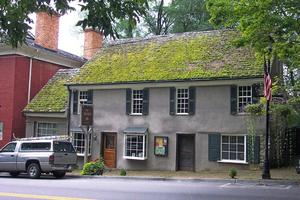

The Tavern
The 70th Virginia Highlands Festival invites you explore historic Abingdon, Virginia, while learning about the region’s culture and history.
Thirteen of Abingdon’s most historic houses are open on “The Abingdon Historic Homes Tour†event Friday, Aug. 3, from 10 a.m. to 4 p.m. All of the properties are within walking distance of each other downtown.
Here is a listing of this year’s homes on tour:
129 East Main Street: The Valentine Baugh House was originally a log cabin built in 1798, then added onto in 1807.
171 East Main Street: Wealthy merchant Colonel James White built this Federal-style house in 1819. It burned in December 1864 during the Civil War and was re-built by Col. White’s son.
Plumb Alley (behind Col. James White’s house): This homestead was constructed from multiple original log homes which were moved to this site to form an authentic example of an early working farm.
Virginia Highlands Festival presents chance to tour historic homes
222 East Main Street: The Tavern was built in 1779, making it the oldest building in Abingdon. Tours close at 3 p.m.
225 East Main Street: The Bank was built to serve as residence and business address for the Exchange Bank, established in 1849 with Robert Preston its first cashier.
228 East Main Street: Washington House, Abingdon’s first hotel, was built in 1835 by Thomas Findlay, serving stage coach and other business travelers, as well as housing professionals.
218 Pecan Street: This cottage was built in 1942 along with several similar structures constructed on Pecan Street at that time.
107 Park Street: Rick and Susan Humphreys have restored this 1834 structure. Interesting aspects are its front porch, original basement kitchen, stone foundation, and clapboard siding.
119 Park Street: Built in 1840, this is another restoration by Rick and Susan Humphreys. Completed in 2003, many architectural details were saved.
262 Bradley Street: This house was built in 1908 and is an Edwardian style home with seven fireplaces.
179 West Valley Street: The Legard House was built in 1912 features five original Italian marble fireplaces, original woodwork and large pocket floors.
255 West Valley Street: This pink Queen Anne Victorian home was built in 1895. It features two formal living areas, original woodwork and hardwood floors, an extensive front porch and the original staircase.
Sinking Spring Cemetery, West End of Valley Street: The cabin was owned by the Cummings family for many years until 1968 when it was donated to the church, which had it moved to the corner of Sinking Spring Cemetery, the location of the original “log meeting house.â€
Tickets are $20 and can be purchased on the festival’s website ahead of time or at The Bank at 225 East Main Street or the Read house at 132 West Valley Street. To learn more visit www.vahighlandsfestival.org.